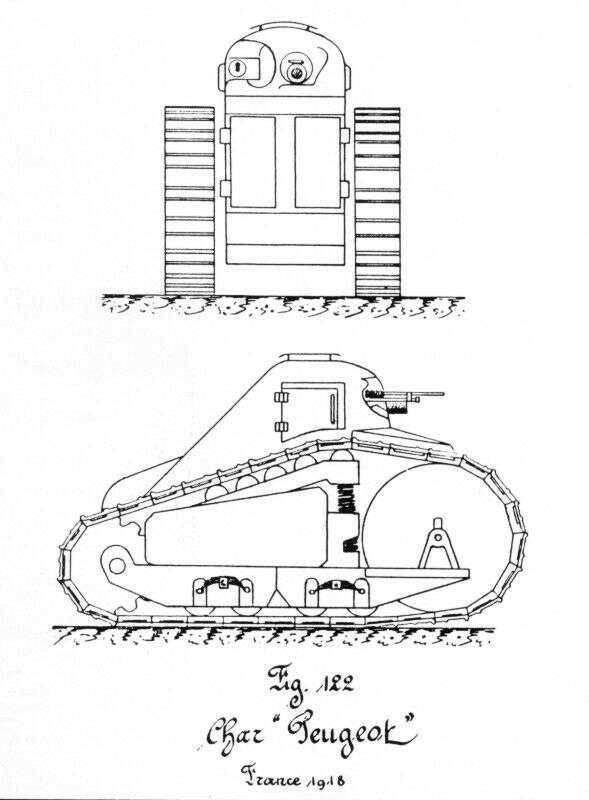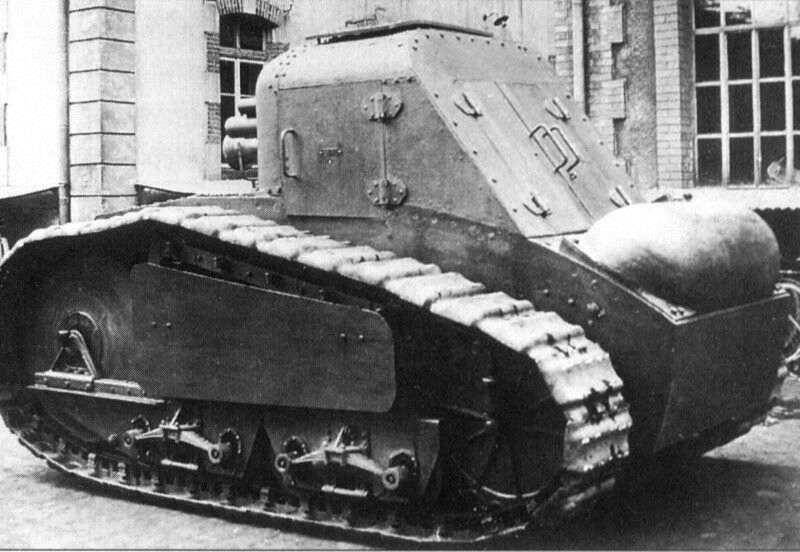Light French tank Char Peugeot

At the initial stage of development of tank technology, French designers managed to create a very successful machine, which was in demand not only in the French army, but also in many countries of the world. This is the famous light tank Renault FT-17, which compares favorably with the first huge dreadnought tanks that appeared during the First World War. It was from the Renault FT-17 that, in many ways, all modern tank building began. It is not surprising that this rather successful car quickly found imitators.
Renault's closest competitor was the equally well-known French company Peugeot, whose specialists were shocked by the huge size of the military order for the FT-17 tank. Only in the 1917-1918 years of the French army were delivered at least 3177 FT-17 tanks, while the 514 of such tanks were delivered to the US Army. For those years, such a military order was considered simply huge. That is why the company Peugeot decided not to stay away from such a golden stream, which, it would seem, flowed to them right in the hands. As a result, the company presented its version of the tank Char Peugeot 1918, which was largely based on the successful model of its direct competitors. The chief engineer of the tank was Captain Omishen.

Tank Char Peugeot began to design in 1918 year, in the same year the first prototype of the combat vehicle was ready. A total of 2 unarmored tank prototypes were assembled, which only began to be tested at the end of 1918, when the outcome of the war left no doubt. After the capitulation of Germany, the army abandoned this project, having a Renault FT-17 tank fully suiting the military in its hands. This machine was able to literally seize the global market and spread throughout the world. These tanks and their modifications could be found from Paraguay and Brazil to Iran and Japan. Total 7820 tanks were released Renault FT-17 various options. Peugeot’s development was not able to compete with it.
Peugeot began to develop its own light tank in parallel with the Renault FT-17 tank, which already had undoubted success on the battlefields of the First World War. The development of Peugeot has a number of both positive and negative qualities. The positive qualities of the machine could be attributed to more powerful weapons, the possibility of installing a short-barreled gun on the 75-mm tank, better booking, and a simpler undercarriage were considered. In this case, the tank had obvious drawbacks. These included the absence of a rotating tower. The gun in Char Peugeot 1918 was installed in the armored cabin. At the same time, the rotating tower, which was used in the Renault FT-17, has become the standard in tank building for many years to come.
The initiator of the development of the tank Char Peugeot, as well as one of its main designers was Captain Omishen, who proposed a design that looks similar to the Renault tank, but without a tower and with a simplified suspension. For example, in relation to one side of the car, the chassis consisted of 4-x track rollers, which were pairwise blocked into two carriages with cushioning, made on spring springs, a rear driving wheel, front guide wheel and 5-supporting rollers.

At the same time, the opening elements of the tank suspension were covered with armored shields - screens. The body of the tank Char Peugeot had a riveted structure. The tank was distinguished from its competitor for the better by the rather spacious cabin in which the weapon was installed. On the sides of the hull, as well as in the tilting armor-sheet installed under the slope, the doors were placed, which served for the landing-landing of the crew of the tank, as well as loading ammunition into the vehicle. The main armament of the tank was a cannon. At the same time in various sources, you can find different versions of the proposed weapons. From the 37-mm SA18 semi-automatic cannon, which was mounted on Renault FT-17 tanks, to the 75-mm short-barrel howitzer Blockhouse Schneider. On the photos that have come down to us, the tank appears with the 75-mm barrel. The gun was mounted in the front hull sheet in a ball mount and was shifted to the left side of the machine. On the right side of the gun there was a driver’s seat, which was equipped with a viewing device. As an alternative, the tank could only be equipped with machine-gun armament using Hotchkiss 8-mm machine guns.
Tank Char Peugeot was able to come to the test only at the end of 1918, when the outcome of the First World War did not cause any doubts. The defeat of Germany was a matter of months. For this reason, despite a number of positive features, the Char Peugeot 1918 tank is located on the same level as the Renault FT-17, without having any exceptional advantages over the latter. In this situation, the army abandoned the novelty in favor of the version already mastered in production, and the Peugeot project was canceled. In addition, the FT-17 tank had some potential for further development. Later on, a version with an 17-mm gun was created on the basis of FT-75. In fact, it was one of the first ACS, which received the designation Renault FT-17 BS.
Information sources:
http://www.aviarmor.net/tww2/tanks/france/char_peugeot.htm
http://gunter-spb.livejournal.com/1355608.html
http://shushpanzer-ru.livejournal.com/1904275.html
Information